Design of Driving Waveform Based on a Damping Oscillation for Optimizing Red Saturation in Three-Color Electrophoretic Displays
Abstract
1. Introduction
2. Principle of Electrophoretic Displays (EPDs)
3. Design of Driving Waveforms
4. Results and Discussion
4.1. Construction of Test Platform
4.2. Erasing Stage Optimization
4.3. Particle Activation Stage Optimization
4.4. Waveform Design of the Damping Oscillation
4.5. Red Display Stage Optimization
5. Conclusions
Author Contributions
Funding
Institutional Review Board Statement
Informed Consent Statement
Data Availability Statement
Conflicts of Interest
References
- Heikenfeld, J.; Drzaic, P.; Yeo, J.S.; Koch, T. Review paper: A Critical review of the present and future prospects for electronic paper. J. Soc. Inf. Disp. 2011, 19, 2. [Google Scholar] [CrossRef]
- Yi, Z.C.; Liu, L.W.; Wang, L.; Li, W.; Shui, L.L.; Zhou, G.F. A driving system for fast and precise gray-scale response based on amplitude–frequency mixed modulation in tft electrowetting displays. Micromachines 2019, 10, 732. [Google Scholar] [CrossRef]
- Dou, Y.Y.; Chen, L.; Li, H.; Tang, B.; Henzen, A.; Zhou, G.F. Photolithography fabricated spacer arrays offering mechanical strengthening and oil motion control in electrowetting displays. Sensors 2020, 20, 494. [Google Scholar] [CrossRef] [PubMed]
- Lee, J.K.; Kim, S.S.; Park, Y.I.; Kim, C.D.; Hwang, Y.K. In-cell adaptive touch technology for a flexible e-paper display. Solid State Electron. 2011, 56, 159–162. [Google Scholar] [CrossRef]
- Inoue, S.; Kawai, H.; Kanbe, S.; Saeki, T.; Shimoda, T. High-resolution microencapsulated electrophoretic display (EPD) driven by poly-Si TFTs with four-level grayscale. IEEE Trans. Electron. Devices 2002, 49, 1532–1539. [Google Scholar] [CrossRef]
- Yi, Z.C.; Huang, Z.Y.; Lai, S.F.; He, W.Y.; Wang, L.; Chi, F.; Zhang, C.F.; Shui, L.L.; Zhou, G.F. Driving waveform design of electrowetting displays based on an exponential function for a stable grayscale and short driving time. Micromachines 2020, 11, 313. [Google Scholar] [CrossRef] [PubMed]
- Chrstophersen, M.; Phlips, B.F. Recent patents on electrophoretic displays and materials. Recent Pat. Nanotechnol. 2019, 4, 137–149. [Google Scholar] [CrossRef]
- Qin, Z.; Wang, H.I.; Chen, Z.Y.; Chen, C.H.; Tien, P.L.; Liu, M.H.; Liu, S.C.; Hung, C.M.; Tsai, C.C.; Huang, Y.P. Digital halftoning method with simultaneously optimized perceptual image quality and drive current for multi-tonal electrophoretic displays. Appl. Optics 2020, 59, 201–209. [Google Scholar] [CrossRef] [PubMed]
- Comiskey, B.; Albert, J.D.; Yoshizawa, H.; Jacobson, J. An electrophoretic ink for all-printed reflective electronic displays. Nature 1998, 394, 253–255. [Google Scholar] [CrossRef]
- Shen, S.T.; Gong, Y.X.; Jin, M.L.; Yan, Z.B.; Xu, C.; Yi, Z.C.; Zhou, G.F.; Shui, L.L. Improving electrophoretic particle motion control in electrophoretic displays by eliminating the fringing effect via driving waveform design. Micromachines 2018, 9, 143. [Google Scholar] [CrossRef]
- Kao, W.C.; Chen, H.Y.; Liu, Y.H.; Liou, S.C. Hardware engine for supporting gray-tone paintbrush function on electrophoretic papers. J. Disp. Technol. 2014, 10, 138–145. [Google Scholar] [CrossRef]
- Yang, S.H.; Lin, F.C.; Huang, Y.P.; Shieh, H.P.D. Ghosting reduction driving method in electrophoretic displays. SID Symp. Dig. Tech. Pap. 2012, 43, 1361–1364. [Google Scholar] [CrossRef]
- Kao, W.C.; Tsai, J.C. Driving method of three particle electrophoretic displays. IEEE Trans. Electron. Device 2018, 65, 1023–1028. [Google Scholar] [CrossRef]
- He, W.Y.; Yi, Z.C.; Shen, S.T.; Huang, Z.Y.; Liu, L.W.; Zhang, T.Y.; Li, W. Driving waveform design of electrophoretic display based on optimized particle activation for a rapid response speed. Micromachines 2020, 11, 498. [Google Scholar] [CrossRef] [PubMed]
- Yang, B.R.; Wang, Y.C.; Wang, L. The design considerations for full-color e-paper. Adv. Disp. Technol. VII. 2017, 10126, UNSP1012602. [Google Scholar] [CrossRef]
- Wang, L.; Yi, Z.C.; Jin, M.L.; Shui, L.L.; Zhou, G.F. Improvement of video playback performance of electrophoretic displays by optimized waveforms with shortened refresh time. Displays 2017, 49, 95–100. [Google Scholar] [CrossRef]
- Yi, Z.C.; Bai, P.F.; Wang, L.; Zhang, X.; Zhou, G.F. An electrophoretic display driving waveform based on improvement of activation pattern. J. Cent. South Univ. 2014, 21, 3133–3137. [Google Scholar] [CrossRef]
- Wang, W.; Zhang, A.; Jiang, Y.F.; Lan, D.S.; Lu, F.H.; Zheng, L.L.; Zhuang, L.; Hong, R.J. Large-scale preparation of size-controlled Fe3O4@SiO2 particles for electrophoretic display with non-irdescent structural colors. RSC Adv. 2019, 9, 498–506. [Google Scholar] [CrossRef]
- Cao, J.X.; Qin, Z.; Zeng, Z.; Hu, W.J.; Song, L.Y.; Hu, D.L.; Wang, X.D.; Zeng, X.; Chen, Y.; Yang, B.R. A convolutional neural network for ghost image recognition and waveform design of electrophoretic displays. IEEE Trans. Consum. Electron. 2020, 66, 356–365. [Google Scholar] [CrossRef]
- Kao, W.C.; Liu, J.J.; Chu, M.I.; Wang, Y.K.; Yang, T.H. Photometric calibration for image enhancement of electrophoretic displays. In Proceedings of the IEEE International Symposium on Consumer Electronics (ISCE 2010), Braunschweig, Germany, 7–10 June 2010. [Google Scholar]
- Kao, W.C.; Chang, W.T.; Ye, J.A. Driving waveform design based on response latency analysis of electrophoretic displays. J. Disp. Technol. 2012, 8, 596–601. [Google Scholar] [CrossRef]
- Johnson, M.T.; Zhou, G.F.; Zehner, R.; Amundson, K.; Henzen, A.; VandeKamer, J. High-quality images on electrophoretic displays. J. Soc. Inf. Disp. 2006, 14, 175–180. [Google Scholar] [CrossRef]
- Kim, J.-M.; Kwangjoon, K.; Lee, S. Multilevel driving waveform for electrophoretic displays to improve grey levels and response characteristics. Electron. Lett. 2014, 50, 1925–1927. [Google Scholar] [CrossRef]
- Cho, K.M. An analysis of reflectivity and response time by charge -to-mass of charged particles in an electrophoretic displays. Trans. Electr. Electron. Mater. 2016, 17, 212–216. [Google Scholar] [CrossRef]
- Lu, C.M.; Wey, C.L. A controller design for high-quality images on microcapsule active-matrix electrophoretic displays. J. Inf. Disp. 2012, 13, 21–30. [Google Scholar] [CrossRef]
- Xu, K.P.; Huang, J.Y.; Liang, H.J.; He, Z.W.; Gao, M.Y. An FPGA based frame rate enhancer for LCD display in embedded systems. Adv. Des. Res. Manuf. 2012, 605, 2095–2099. [Google Scholar] [CrossRef]
- Wang, L.; Yi, Z.C.; Peng, B.; Zhou, G.F. An improved driving waveform reference grayscale of electrophoretic display. In Proceedings of the Volume 9672, AOPC 2015: Advanced Display Technology; and Micro/Nano Optical Imaging Technologies and Applications, Beijing, China, 5 May 2015; Volume 9672, pp. 967204–967209. [Google Scholar] [CrossRef]
- Duan, F.B.; Bai, P.F.; Henzen, A.; Shui, L.L.; Tang, B.A.; Zhou, G.F. An adaptive generation method for electrophoretic display driving waveform design. J. Soc. Inf. Disp. 2016, 24, 676–685. [Google Scholar] [CrossRef]
- Kao, W.C.; Ye, J.A.; Lin, F.S.; Cheng, P.Y.; Sprague, R. Configurable timing controller design for active matrix electrophoretic display. IEEE Trans. Consum. Electron. 2009, 55, 1–5. [Google Scholar] [CrossRef]
- Yu, D.; An, J.H.; Bae, J.Y.; Jung, D.; Kim, S.; Ahn, S.D.; Kang, S.; Suh, K.S. Preparation and characterization of acrylic-based electronic inks by in situ emulsifier-free emulsion polymerization for electrophoretic displays. Chem. Mater. 2004, 16, 4693–4698. [Google Scholar] [CrossRef]
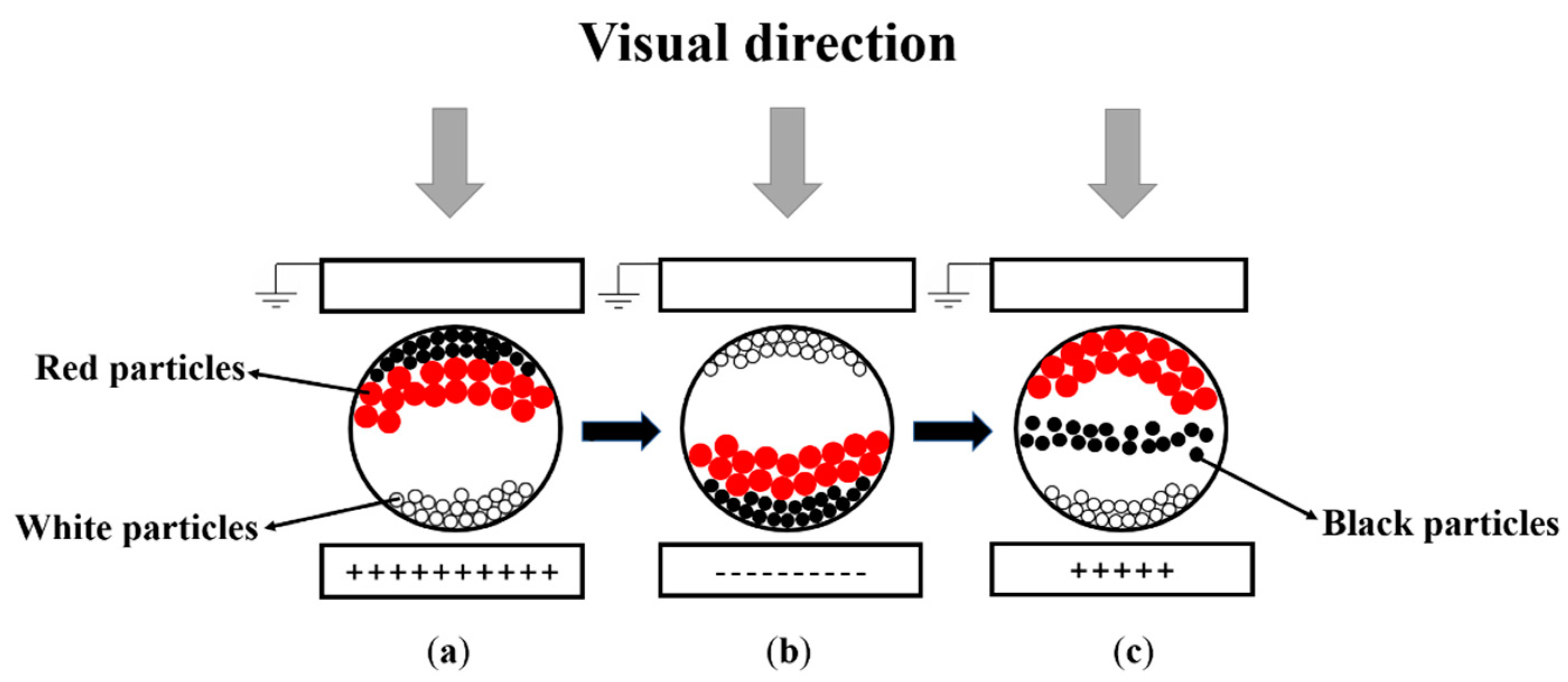
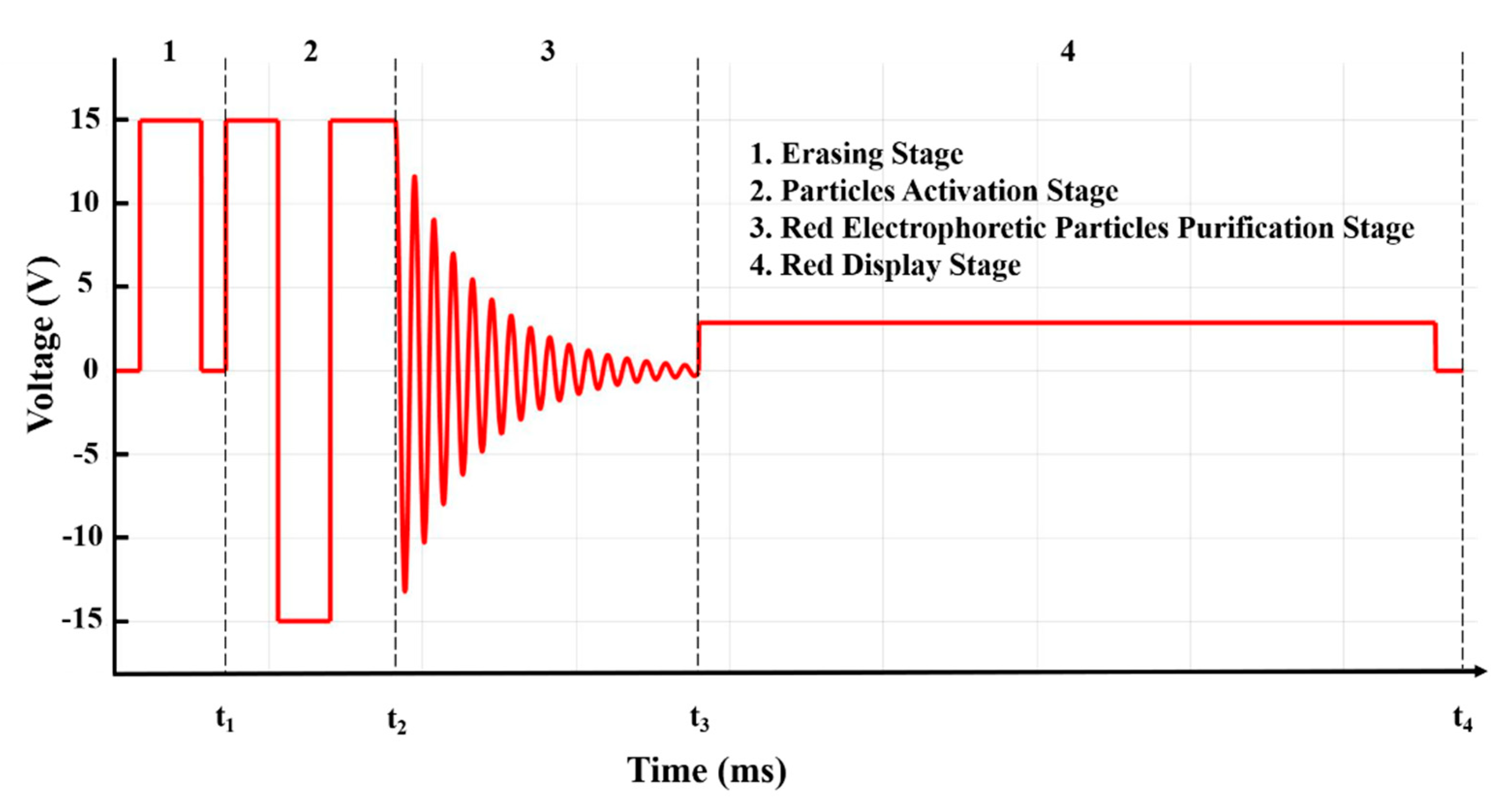


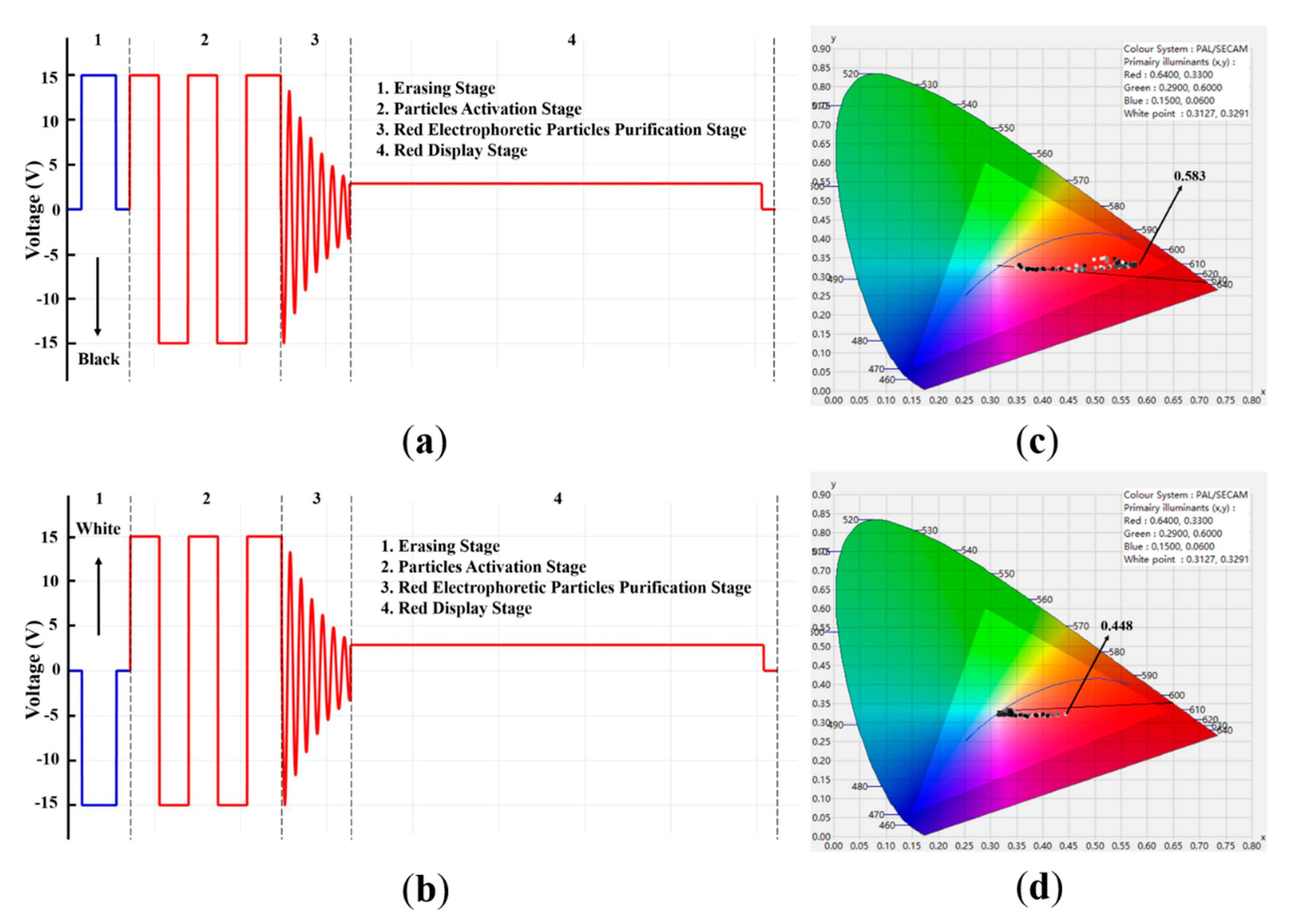
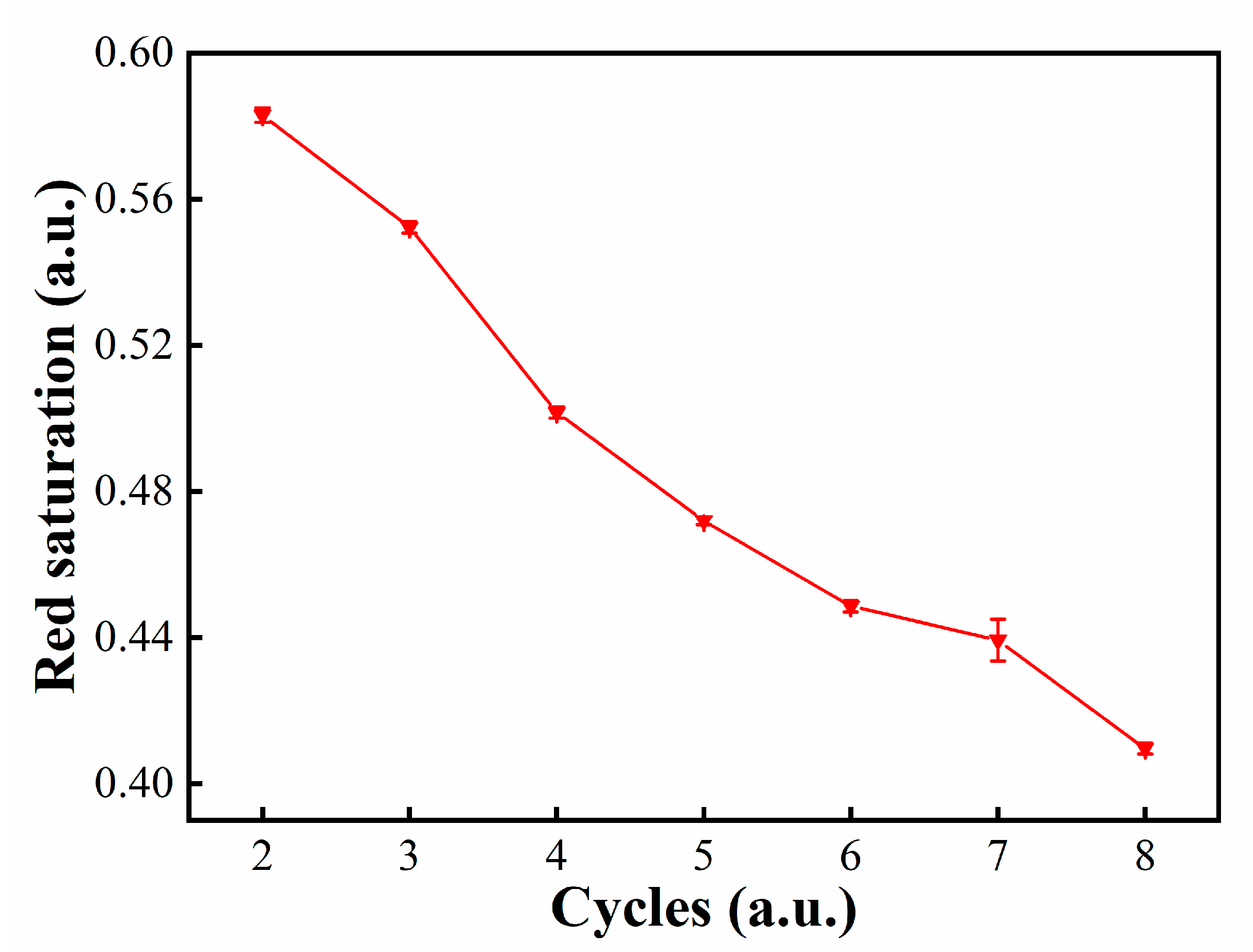

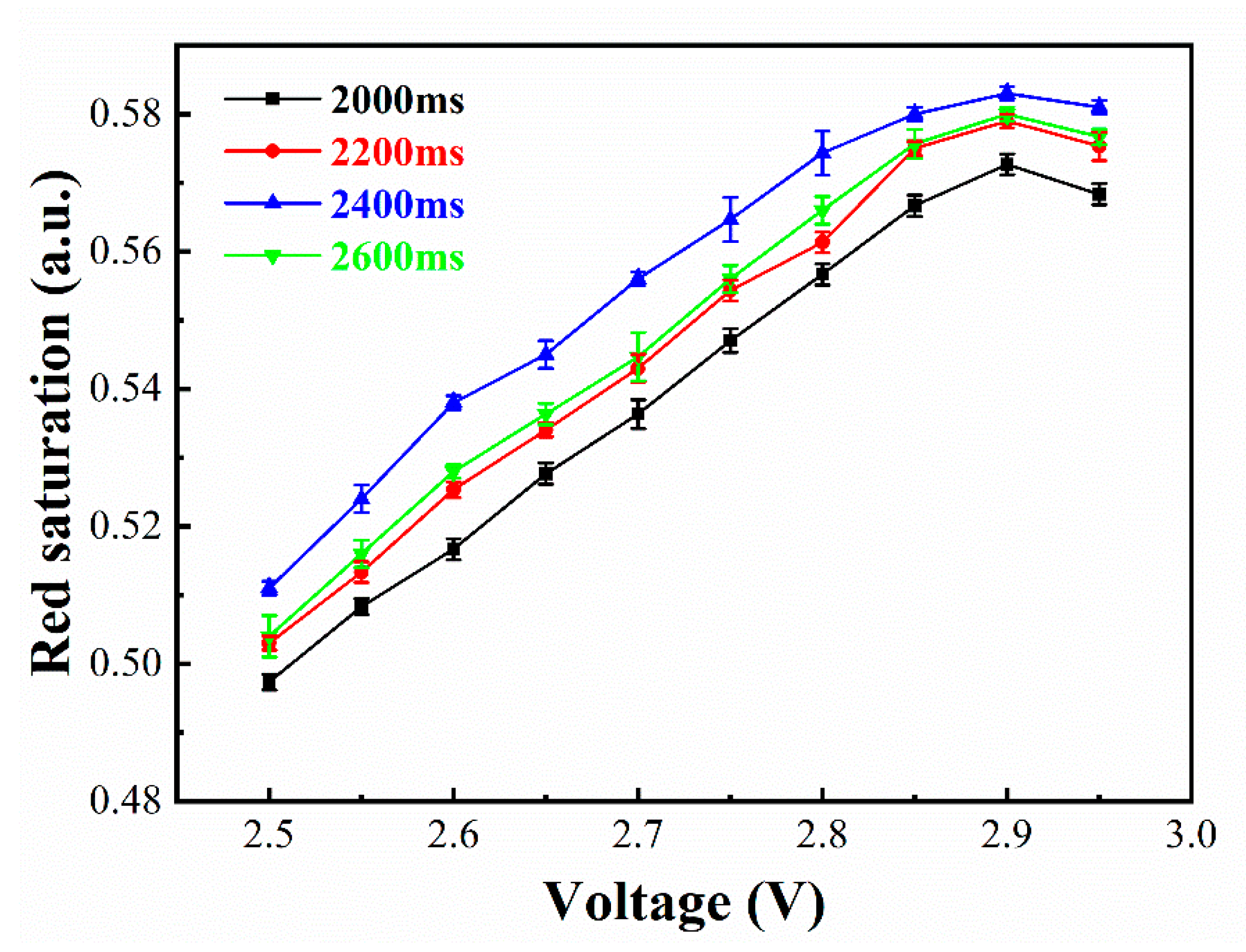
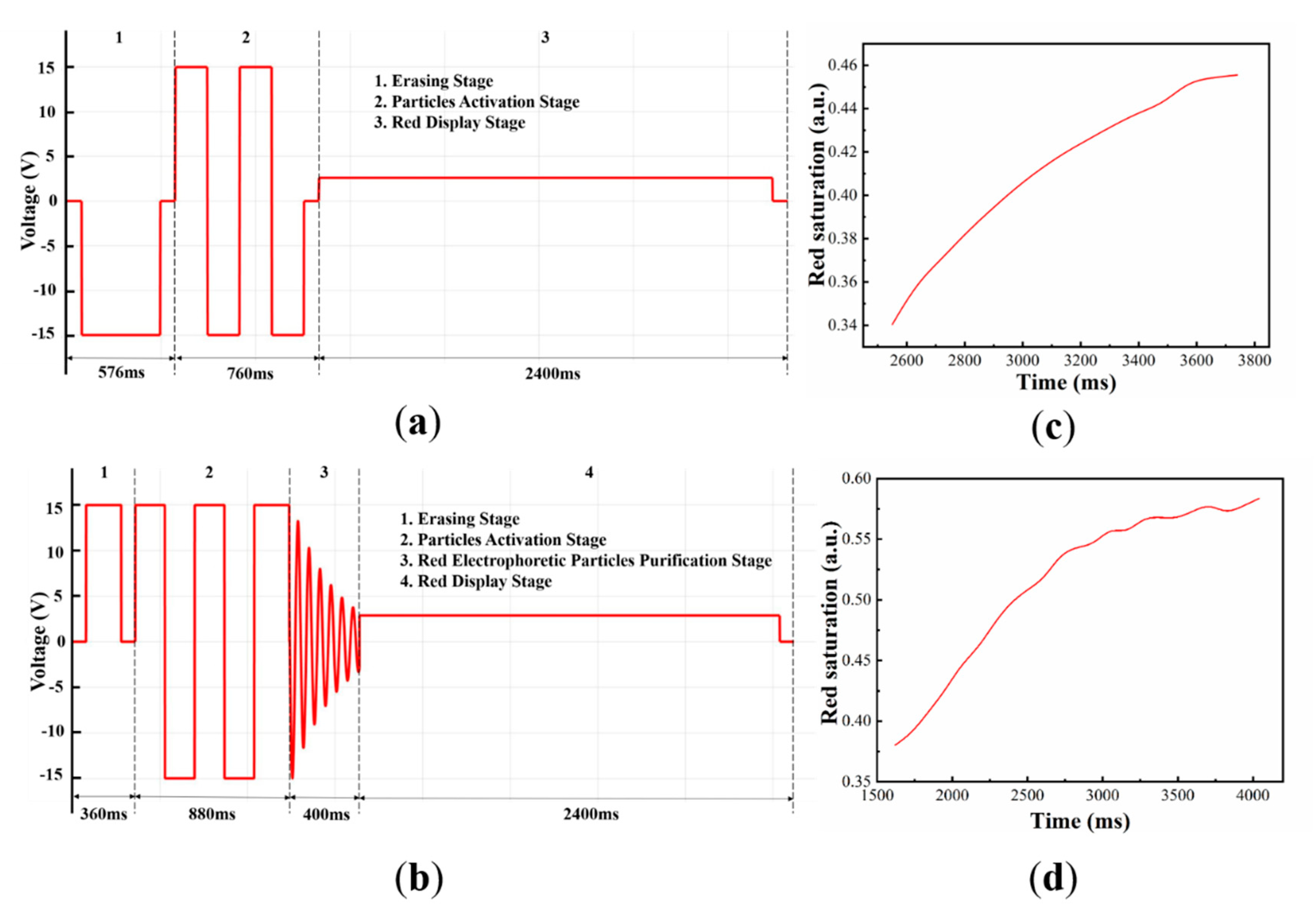
Publisher’s Note: MDPI stays neutral with regard to jurisdictional claims in published maps and institutional affiliations. |
© 2021 by the authors. Licensee MDPI, Basel, Switzerland. This article is an open access article distributed under the terms and conditions of the Creative Commons Attribution (CC BY) license (http://creativecommons.org/licenses/by/4.0/).
Share and Cite
Yi, Z.; Zeng, W.; Ma, S.; Feng, H.; Zeng, W.; Shen, S.; Shui, L.; Zhou, G.; Zhang, C. Design of Driving Waveform Based on a Damping Oscillation for Optimizing Red Saturation in Three-Color Electrophoretic Displays. Micromachines 2021, 12, 162. https://doi.org/10.3390/mi12020162
Yi Z, Zeng W, Ma S, Feng H, Zeng W, Shen S, Shui L, Zhou G, Zhang C. Design of Driving Waveform Based on a Damping Oscillation for Optimizing Red Saturation in Three-Color Electrophoretic Displays. Micromachines. 2021; 12(2):162. https://doi.org/10.3390/mi12020162
Chicago/Turabian StyleYi, Zichuan, Weibo Zeng, Simin Ma, Haoqiang Feng, Wenjun Zeng, Shitao Shen, Lingling Shui, Guofu Zhou, and Chongfu Zhang. 2021. "Design of Driving Waveform Based on a Damping Oscillation for Optimizing Red Saturation in Three-Color Electrophoretic Displays" Micromachines 12, no. 2: 162. https://doi.org/10.3390/mi12020162
APA StyleYi, Z., Zeng, W., Ma, S., Feng, H., Zeng, W., Shen, S., Shui, L., Zhou, G., & Zhang, C. (2021). Design of Driving Waveform Based on a Damping Oscillation for Optimizing Red Saturation in Three-Color Electrophoretic Displays. Micromachines, 12(2), 162. https://doi.org/10.3390/mi12020162






